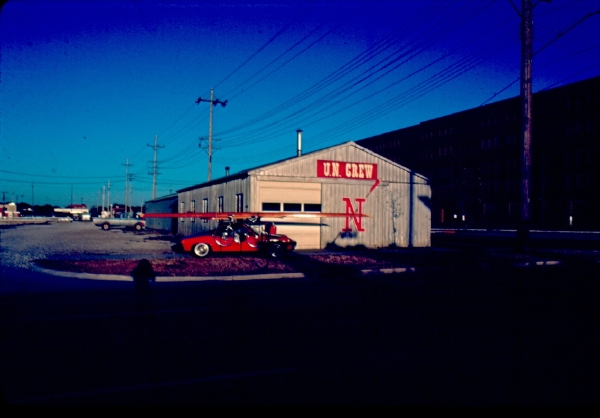Projects
"Rowing? In Nebraska?" The UNL Crew Club: 1969-1980Project Editor: Joshua Vapenik, History 470: Digital History, Spring 2008 Table of Contents
Storage
|
Storage
Rowing shells need a safe place to be stored while not in use. Though they are relatively strong despite their thin wooden makeup, the fact remains that a careless foot or blunt object can punch a hole through one easily. Also, the elements and especially the Midwestern winter are rough on rowing equipment, especially equipment made out of wood such as was used in the 70s. In order to get the maximum lifetime of use out of that equipment, it need to be stored inside somewhere. Additionally, the average eight is 60 to 70 feet long, so somewhere rather large would be required to house a shell.
One of the important things for the founding members to find, then, was somewhere safe and dry to keep their equipment safe and out of the elements when not in use. The University, however, refused to offer any such facility to the team, and building a boathouse was far too expensive and therefore out of the question.
Faced by the university's refusal to give them space to store their equipment, the team began squatting in an abandoned shed. In a clandestine late night raid, members cut off the lock to an old shed previously used for streetcar repairs, placed their shells and oars inside, and replaced the lock with one of their own. Though at first unwilling to allow the team remain in the building without its permission, the University eventually relented and allowed them to stay.
More needed to be done to make the newly acquired boathouse usable, however. In order to store the shells inside, racks needed to be built to safely and neatly hold the shells off the floor. As was always the case though, the team had no money to spare for the required wood. So in a series of late night raids, members took a few boards every night from the loading dock at a nearby manufacturing plant until they had enough to build racks for the boats. "Each day, their dock got smaller," laughed Maybee in a newspaper interview years later. "I only tell you this because the statute of limitations has expired" .
The boathouse continues to house the Team to this day. Not only does it serve as a storage facility for the team's equipment, it is also where the team's rowers practice in the wintertime and the site of the team's weekly meetings. In many ways it is the focal point of all the team's activities and the group's culture.

| A photograph of the Boathouse as it appeared around 1976. Notice the real oar behind the red wooden "N." This particular oar is known as a "spoon" due to the shape of the blade. At this time the Boathouse still remains unpainted and retains the original garage door on the west wall of the tank area. At this time the Boathouse remained unpainted; later in life it would sport a coat of white paint to protect the metal from the elements. Also note the wooden single on top of the car.
|
|

